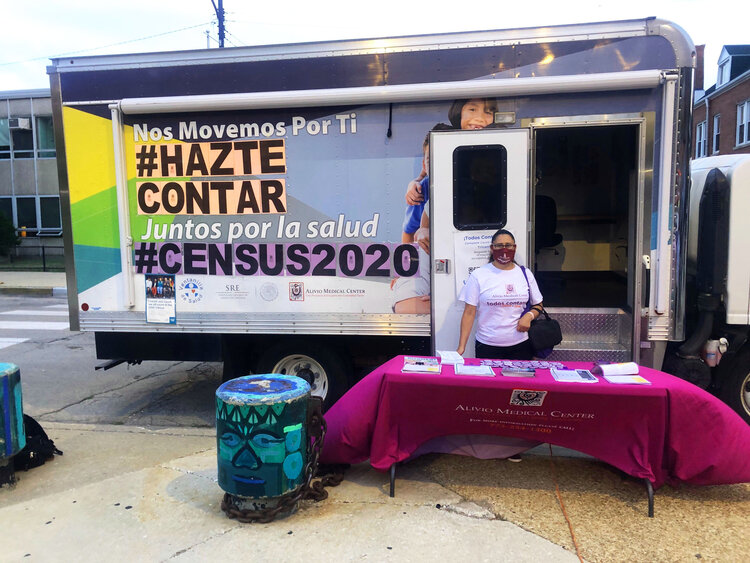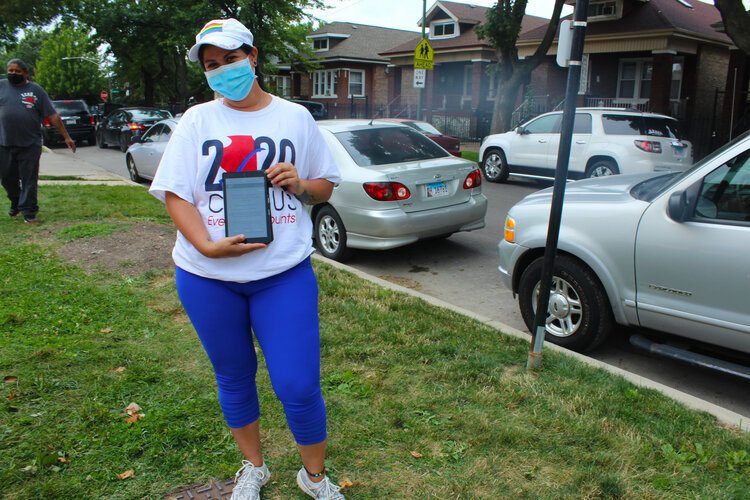-
The Race to Count Immigrant Communities in the Census

As time runs out, some of the neighborhoods in Chicago with the lowest census response rates are those with high numbers of Latinx immigrants.
 Pilar Rodriguez approached community members about the census at “El Zocalo” plaza in Pilsen. She noticed hesitancy from some Latinx community members on this year’s census. (Photo: Alexandra Arriaga)
Pilar Rodriguez approached community members about the census at “El Zocalo” plaza in Pilsen. She noticed hesitancy from some Latinx community members on this year’s census. (Photo: Alexandra Arriaga)By Alexandra Arriaga | City Bureau
This story was originally published by City Bureau on 08.26.2020Pilar Rodriguez sat at a table full of census brochures in front of a popular outdoor Zumba class in Pilsen during the first week of August. As the sun set, a group of mostly Latina women exercised to loud music while their children played nearby.
Rodriguez is a census ambassador for Alivio Medical Center, a clinic in Pilsen contracted by Cook County for census outreach. That evening, she approached people in the plaza for a few hours, talking to families in both English and Spanish to make sure they were counted in the 2020 census. But even at a joyful event like this, she picked up on some hostility.
“Many people fear the census,” Rodriguez said in Spanish.
The Trump administration’s attempted changes to the census have stoked fear and discouraged immigrants from responding, according to PRI The World reporting. On top of delays in outreach due to the COVID-19 pandemic, the U.S. Census Bureau announced recently it will end all counting efforts one month sooner than planned on September 30.
With just one month left, nearly one in every four U.S. households still need to be counted. This huge gap to connect with the nation’s hardest-to-reach residents includes some of Chicago’s immigrant communities. In the final stretch before the new deadline, census workers can be seen in neighborhoods with low response rates throughout Chicago, in a race against time to complete as many census forms as possible.
Which immigrant communities in Chicago have the lowest response rates?
According to recently reported response rates on Aug. 26, census tracts in Back of the Yards, Englewood and Little Village have some of the lowest response rates city wide—ranging from 25% to 32%. The census tract with the lowest response rate in Chicago is in Back of the Yards where almost half of the tract’s population is foreign-born, with 89% from Latin America. In this tract, the current response rate is at 25.8%, far below the 2010 final response rate of 44.6%. Citywide, Chicago’s response rate is at 57.9%, still below the goal of 75% or the 2010 response rate of 66%.However, not all census tracts with high foreign-born populations have low census response rates. The tracts with the highest foreign-born populations in Chicago—located in West Ridge, Edgewater and Chinatown—also have average response rates that range between 55% to 70%. The national 2020 census response rate as of Aug. 26 is 64.6%, according to the U.S. Census Bureau website.
“The immigrant community [in Chicago] as a whole is very diverse, and looking at the foreign-born population alone doesn't account for the many other factors that make a community hard-to-count, such as the presence of young children, housing insecurity and income levels that all contribute to civic participation,” said Brandon Lee, an Illinois Coalition for Immigrant and Refugee Rights census consultant.
Lee also mentioned that census outreach partners hear that warnings about ICE have played a role in some of the mistrust and low response in areas like Little Village and Back of the Yards.
How are census workers reaching out to these hard-to-count immigrant communities?
Under normal circumstances, census workers would have been knocking on doors since March. Local libraries, street festivals and block parties were slated to be public spaces where anyone could complete the census on computers. The pandemic shut down many of those opportunities.But the strategy—to meet people where they are—remains the same. ICIRR funded and oversees community partners throughout the state for census outreach efforts through a $2.4 million grant from the Illinois Department of Human Services, South Side Weekly reported.
Instead, census outreach workers like Rodriguez post up near popular outdoor spots like fitness-in-the-park classes, pop-up food banks, or drive through neighborhoods in census caravans to reach families who haven’t yet filled out the census. One organization, the Brighton Park Neighborhood Council, even collaborated with a laundromat to give residents a free laundry day in exchange for filling out a census form.
One Saturday in August, Brighton Park Neighborhood Council volunteer Maribel Sanchez filled out census forms for 30 to 35 people at Enrico Tonti Elementary School in Gage Park. All morning she dutifully unpacked fruit, vegetables, meat and milk at the food distribution site. After setting up the supplies for the day, she approached people in the line wrapped around the block to fill out their census forms.
“Many people lack information, some lack internet access or don’t know how to use it, so we help them because we all count,” said Sanchez in Spanish.
 Maribel Sanchez, a volunteer with the Brighton Park Neighborhood Council, volunteered at a food distribution site before approaching people in line to count them in the census. (Photo: Alexandra Arriaga)
Maribel Sanchez, a volunteer with the Brighton Park Neighborhood Council, volunteered at a food distribution site before approaching people in line to count them in the census. (Photo: Alexandra Arriaga)What motivates immigrants to participate in the census?
As a health worker, Rodriguez says she frames census participation to immigrants around bringing more healthcare resources to their communities.
“Don’t you get sick?” she’ll ask, “and do you have insurance?”
Rodriguez asks this with the understanding that one out of every three patients in the Cook County health system is uninsured, and many are immigrants who don’t qualify for Medicaid. Cook County used census data to start a program that helps uninsured people gain access to healthcare in 2016.
Resources for healthcare, education and other public services motivate immigrants in Chicago to participate in the census. City Bureau Documenters asked 15 first-generation immigrants why they would do the census in May. They gave diverse reasons for participating. Two said they saw it as their “civic duty,” or “like voting.” Six mentioned budgets and resources for their local communities, and two specifically mentioned school funding.
There was also a sense that people want to be counted for the sake of recognition and representation. Eight people from traditionally undercounted immigrant communities said they planned to complete the census this year because they want to establish that they exist and, in turn, gain more political representation.
“We want to be counted,” one respondent from the Philippines said. “We want to let them know that we’re existing, man.”
Who’s most likely to be missed in the census count?
Children under five can be particularly difficult to count, and are often a demographic with a lot at stake. If children go undercounted, programs like Medicaid, the Children’s Health Insurance Program (CHIP), the Supplemental Nutrition Assistance Program (SNAP), special education and preschool programs, may lose funding. Overall, Illinois risks losing $195 million each year for every 1% of the population that goes undercounted, according to state officials.
Nationally, Latinx children are at a high risk of being undercounted. In Cook County, 130,949 children are at a high risk of being undercounted, according to data from the Population Reference Bureau.Neighborhoods in Chicago with children under five living in immigrant families are at greater risk of an undercount. “Based on the characteristics we identified, these are areas with high shares of kids living in poverty, in female-headed households, in grandparent-headed households with limited English speaking abilities,” said Mark Mather from the Population Reference Bureau.
The census can be filled out online or over the phone by calling, 844-330-2020.
Do you like this page?















